One massive investment opportunity is going largely unnoticed, perhaps by design. A multi-billion-dollar sector, whose main assets are often quite literally hidden in plain sight.
Once you find out what it is... and how much money it makes every month... you'll start hunting for it in your neighborhood. In fact, it might be the most profitable thing in it.
Once You See It, You Can't Ignore It
Unlike most infrastructure projects, this industry does its best to make their assets less visible to the public, while their services reach out to a rapidly growing portion of the population. They like it that way.
With profit margins that are over 80 percent, and a bevy of AAA tenants at the ready to guarantee early and ongoing cash flow, it's a wonder how this industry still remains under the radar of most investors.
But, for those investors who are already aware of this sector, they've been keenly rewarded.
Already, the public market has already witnessed three companies in this field go from $0.50 to $2, and up to over $120 per share. Every one of them has a multi-billion-dollar market cap.
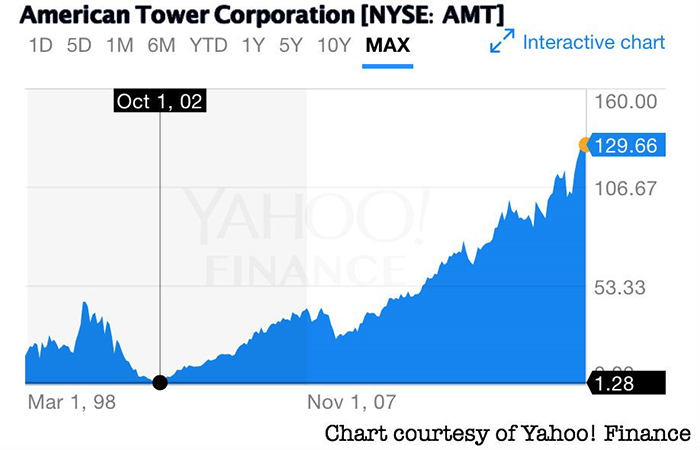
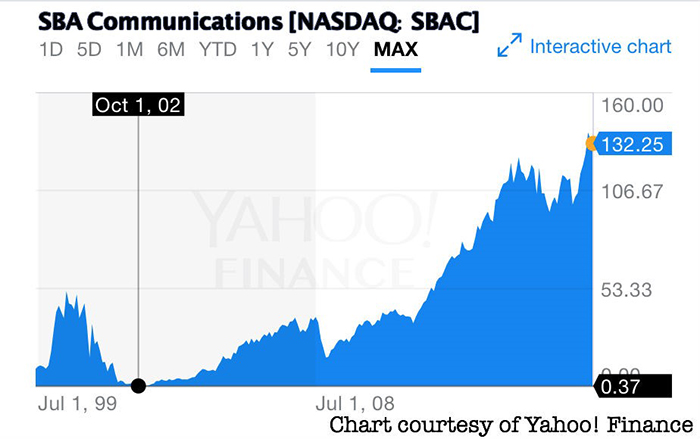
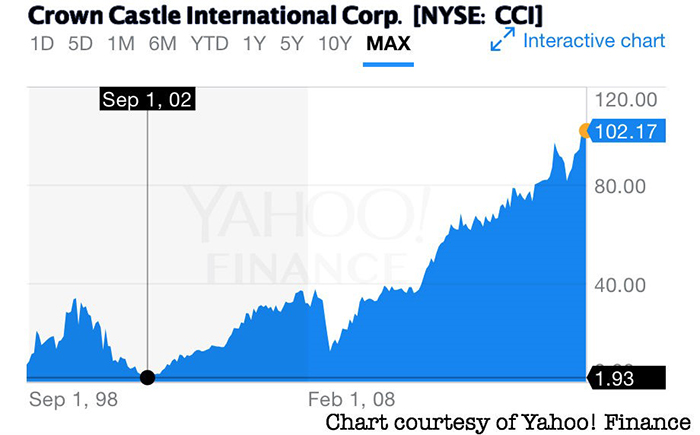
Since recently going public, Tower One (CNX: TO; OTC: TOWTF) is now the fourth publicly-traded company in North America, and is the only small-cap entry point into an industry with 80 percent EBIDTA margins, and near-instant cash flow.
But that doesn't mean competition isn't fierce.
Demand for these low cost, high-yielding assets in question has skyrocketed over the past 10 years, causing the combined market cap of the 3 main companies trading in North America to rise to nearly $110 billion.
This was all with those main companies producing less than half a million units.
And somehow, this low-cost, instant cash flow business model is still under the radar, as investors are literally passing by these assets every day without thinking about them.
Look Up, Way Up
What are they? Look up...
Cell phone towers are everywhere, increasing their coverage every year, all while designers do everything in their power for the public not to notice them.
Towers are often designed to blend in to their surroundings, sometimes being disguised as palm trees, crosses, and public art installations.
And while the market has snoozed on this booming sector, it seems that these towers' disguises worked too well.
Aesthetics aside, these towers are being rapidly dispersed across the world, expanding high speed internet coverage to more and more remote regions. All the while, telecom providers are snapping up leases on the towers to increase their presence, and reliability for customers.
Cell phone towers are an industry that is very straight-forward to leverage, where the owners of the towers can jump into breakeven cash flow on a semester basis, if not less.
And demand for wireless cell phone towers has skyrocketed over the past 10 years in North America and many developed nations.
Now the entire planet is shifting to wireless communication.
There's a reason that the three companies that focused on this niche infrastructure could start from zero, collectively build almost half a million towers, and rise to a combined market cap of almost $110 billion.
Now the wave of high speed mobile data, and telecom coverage is spreading at a rapid rate in the developing world.
And there's only one small-cap entry point available to the average investor today, who wants to get in at the beginning of a major growth arc story.
Tower One Wireless Corp. (CNX: TO; OTC: TOWTF) is entering this market with a niche advantage. It's tackling the surging demand for new towers in South America—particularly in Argentina and Colombia.
Already with a foot in the door, and management's established relationships with the major wireless providers and local governments in the region, Tower One has a very clear path to success.
Liquid Real Estate
An advantage that cell phone tower owners have over other real estate conglomerates is that all of their tenants have an AAA credit rating.
So, to any investor looking at the credit risk side of the industry, it's quite simple.
You build a tower, costing between $50k to $100k (depending on the size), which takes 30 days to build. By day 45, you're already collecting cash flow from tenants with big pockets—namely multi-billion-dollar telecoms.
The return on investment per-tower is what is the most eye-opening aspect of the sector.
The typical client is a multi-billion-dollar telecom, and the typical lease is a monthly payment over 10-20 years.
With just one client in place, the towers can be paid off within a few short years, leaving a majority of the tower's lease to build and compound profit.
An average client's lease on a tower comes to around $12,000 per year, alone. Thus if even just one client is signed, then the tower is paid off before the halfway mark of a ten-year term.
Those profit margins are increased in multiples, every time that the tower is assigned to more than one carrier, with many towers capable of handling up to four tenants without diluting service.
Adding additional clients does not increase the cost of service delivery for the tower owner, but it does increase the profit margin significantly.
Two clients on one tower nearly pays off the construction of the tower in just over two years. Four clients, brings the payback amount down to just over one year, with an income potential of $48,000 per year.
But even with just one client, a single $50,000 tower, can return back $120,000 over the course of a ten-year term. And a 4-client tower is close to $500,000, for a 10x return on initial investment.
Argentina
Tower One (CNX: TO; OTC: TOWTF) has targeted South America as its field for expansion, as the growth in demand is rising in the region more rapidly than in North America.
In particular, the company sees a major opportunity in Argentina, which is making gains after a shift in political policy more towards growth and stability.
Aggressive demand in Argentina has been projected to require an additional 10,000 towers in just three years.
There are five major carriers in Argentina, including moguls Claro (owned by America Movil) [NYSE: AMOV], Tigo (owned by Millicom International) [OTC: MICCF], Telefonica [NYSE: VIV], Telecom Argentina [NYSE: TEO], and Avantel (owned by AXtel). All are multi-billion-dollar giants.
Already with a foothold in Colombia, Tower One's Argentinian expansion plans are blue sky, and give management confidence that they can begin a similar arc to their comparables in the region.
With an already known potential client base, Tower One (much like other tower companies) doesn't have to spend on marketing. Contracts in South America are a result of relationships, a commodity that the Tower One team, which includes the former President and CEO of Deutsche Telekom USA, now T-Mobile (NASDAQ:TMUS), and the former COO of Continental Towers, which built over 200 towers in Colombia under his watch, is already entering the game with.
Tower One (CNX: TO; OTC: TOWTF) has the vision to bring South America into the wireless revolution, and to become a major provider of wireless communication towers to the South American market. In doing so, their mission is to create significant cash-flow, and shareholder value in the process.
Competitors
American Tower Corporation (NYSE: AMT) has a mkt cap of nearly $55.5 billion, having risen from a share price of $1.28 in 2002, to its current share price of $130. American Tower has accrued a portfolio of approximately 147,000 towers, for an average value of over $377,000 per tower.
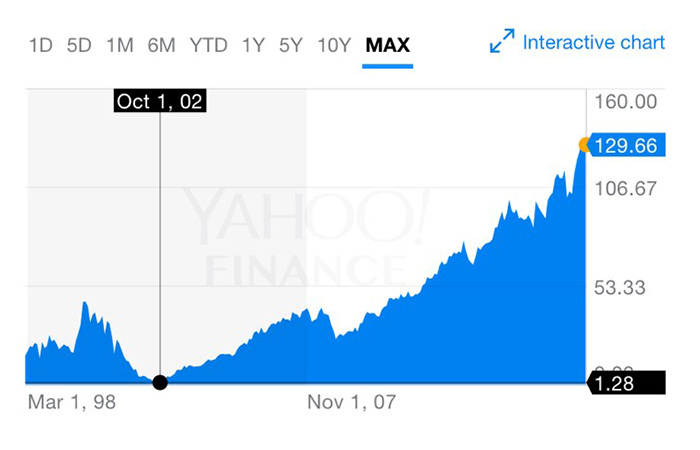
SBA Communications (NASDAQ: SBAC) has a mkt cap of over $16 billion, having risen from $0.37 per share in 2002, to over $132 per share today. SBA has a portfolio of over 26,000 towers for an average value of over $615,000 per tower.
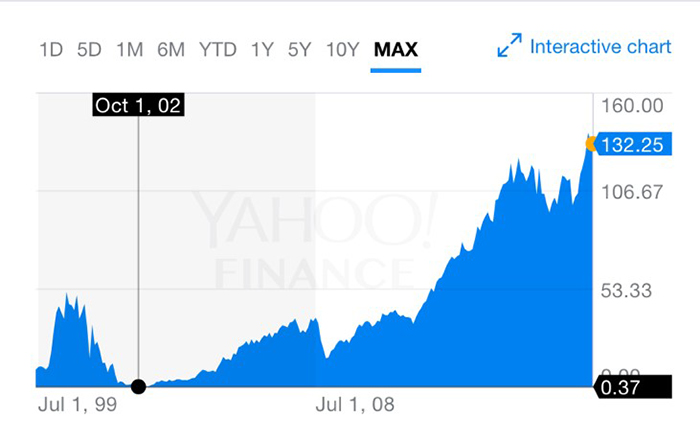
Crown Castle (NYSE: CCI) has a mkt cap of over $37 billion, having risen from $1.93 per share in 2002, to nearly $102 per share today. Crown Castle has a portfolio of approximately 40,000 towers for an average value of over $931,000 per tower.
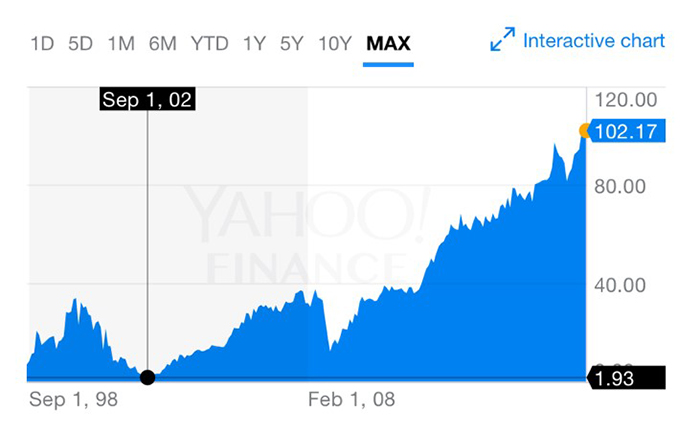
All three comparables are far along in their story, and see value in the South American wireless boom as well. But Tower One has an advantage for investors, in that it's at an earlier stage in the story, but with the same strategy for growth.
Tower One Projections
Currently, Tower One has a portfolio of 11 towers, with another 25 towers under development/construction.
With an initial investment of only $10 million, and a growth path set through an aggressive South American expansion plan, Tower One is seeking to capitalize on a massive demand in a growing industry.
According to America Towers, there are 10,000 new towers required in Argentina alone.
The company has projected itself to be at 100 towers by Q1 of 2018, with a fair value projection of $60.4 million (based on an average per-tower value calculated from the comparables), or a 6x increase from today's market cap.
By Q1 2019, Tower One expects to have amassed 250-300 towers, with a fair value being a $200-300 million market cap, based on a $504,000 value per tower.
Long story short, Tower One projects a future where its $10 million investment can be grown into a value of over $200 million in just two years.
By averaging the per-tower value of the three majors, we get approximately $660,000 per tower, with an average revenue of $51,000 per tower.
As Argentina seeks to build 10,000 new towers in the coming years, that leaves a value of $6.6 billion in towers, with potential revenue of $510 million up for grabs.
Management
And it's likely they'll get the lion's share of the market because...
Tower One (CNX: TO; OTC: TOWTF) is led by Alex Ochoa. The returns Ochoa was witnessing on each tower is what drew Alex Ochoa to the market. In fact, he left being a Director at Mackie Research Capital, one of the top retail and institutional brokerage firms in Canada, to build Tower One Wireless, and capitalize on his relationships formed in South America.
In Latin America, many major projects are largely driven by having a friendly relationship with those in charge of handing out the permits.
The Tower One team are well versed on the business climate in the region, and targeted Argentina specifically as a space that is set to explode in a flurry of new towers.
Ochoa's desire to capitalize on this surprisingly overlooked market led him to assemble a dream team of expertise to see Tower One's vision to fruition.
Among the who's-who on the board and management team, is former President and CEO of Deutsche Telekom USA, now known as T-Mobile, Roland Bopp - who has been brought on as an advisor. His contacts in the very tight-knit world of telecommunications could be Tower One's ace in the hole, as he will have worked on the other side of table in client negotiations for towers, and was a major player as the wireless boom took off.
Taking on the role of COO will be former COO of Continental Towers, Octavio De La Espriella. While at Continental, Octavio helped expand the company's portfolio to over 200 towers in a two-year period. His connections with the major telecoms (Claro, Tigo, Avantel, Movistar) in Colombia is a major asset.
As well, the company has taken a humanitarian initiative in their expansion, by supporting the One Laptop Per Child program, helping bring access to the internet to remote and poorer regions, by giving away tools to children in need of access to learning.
The Inside Track
Soon this story will get out. This is more than a passion project for Alex Ochoa and his team. The opportunity was so good that Ochoa left a prestigious position at Mackie Research to pursue this tower boom.
Management has locked up 60 percent of the shares in the company.
With just a $10 million investment, the company will now begin its path towards major growth targets.
At a starting point of $0.23 per share, and a current market cap of $12 million, Tower One gives investors a chance to enter into a market that has already seen companies such as American Tower, SBA Communications, and Crown Castle have meteoric rises, through steady organic growth.
The company's vision is to finance and build at least 300 towers in the first 24 months, while creating a highly profitable income stream.
At today's prices, that should be worth well over $300 million once they've reached that marker.
Tower One's strategy is to acquire growth to become one of the largest tower companies in South America, with a long-term goal to build a multi-billion-dollar market cap that pays out dividends and continues to grow each year.
At today's affordable share price, there's an incredibly rare entry opportunity into a market where multi-billion-companies are the norm. All of Tower One's competitors are multi-billion-dollar market caps.
If Tower One (CNX: TO; OTC: TOWTF) can hit its two-year goal of 300 towers, which should be worth at least $300 million, that would be 25x the current market cap, all with minimal dilution along the way.
Other companies worth keeping an eye on:
Apivio Systems (TSXV:APV) Apivio Systems Inc is a Canadian technology company which designs, develops and manufactures communications equipment and software. Apivio saw very strong growth in 2016 and we expect the company to continue its upward movement in Q3, Q4 of 2017.
Intrinsyc Technologies (TSX:ITC) Intrinsyc is a product development company that provides hardware, software, and service solutions for embedded and wireless products. This Canadian company saw a few hiccups this year, but we expect the IoT segement to continue to grow fast in the near future.
Bell Alliant (TSX: BA) Bell Aliant is Atlantic Canada's leading provider TV, internet, phone and data services to residential and business customers. We expect the need for high speed internet to increase significantly, and this provider is poised to gain.
CGI Group (TSE:GIB.A) CGI Group Inc., more commonly known as CGI, is a Canadian global information technology consulting, systems integration, outsourcing, and solutions company. CGI provides IT consulting services all over the planet and has seen steady growth over the last 5 years.
Celestica Inc. (TSE:CLS) Celestica is a manufacturer of electrical devices used in IT, telecommunications, healthcare, defense and aerospace industries. The company has seen strong growth YoY which we expect to continue as the sales expectations are almost 3% better than last year's.
Legal Disclaimer/Disclosure: This piece is an advertorial and has been paid for. This document is not and should not be construed as an offer to sell or the solicitation of an offer to purchase or subscribe for any investment. No information in this Report should be construed as individualized investment advice. A licensed financial advisor should be consulted prior to making any investment decision. We make no guarantee, representation or warranty and accept no responsibility or liability as to its accuracy or completeness. Expressions of opinion are those of Baystreet.ca only and are subject to change without notice. Baystreet.ca assumes no warranty, liability or guarantee for the current relevance, correctness or completeness of any information provided within this Report and will not be held liable for the consequence of reliance upon any opinion or statement contained herein or any omission. Furthermore, we assume no liability for any direct or indirect loss or damage or, in particular, for lost profit, which you may incur as a result of the use and existence of the information, provided within this Report.